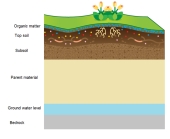
 1
1








Sometimes the answer is nothing

 1
1








Medicinal herbs, kitchen herbs, perennial edibles and berries: https://mountainherbs.net/ grown in the Blue Mountains, Australia




 1
1




When you reach your lowest point, you are open to the greatest change.
-Avatar Aang
 1
1




Gail Saito wrote:Instead of using a compost pile, I have been digging a hole in the soil and putting in my kitchen scraps, run through the blender for a quick chop. Recently I was told by a "soil expert" that my method is not a good idea, as it creates an anaerobic condition in the soil. ...anaerobic...not good! I wanted to run this by permies to get your thoughts. Do you agree with the soil expert? Anyone out there doing the same thing as I've been doing?
 1
1








A human being should be able to change a diaper, plan an invasion, butcher a hog, conn a ship, design a building, write a sonnet, balance accounts, build a wall, set a bone, comfort the dying, take orders, give orders, cooperate, act alone, solve equations, analyze a new problem, pitch manure, program a computer, cook a tasty meal, fight efficiently, die gallantly. Specialization is for insects.
-Robert A. Heinlein





Gail Saito wrote:Instead of using a compost pile, I have been digging a hole in the soil and putting in my kitchen scraps, run through the blender for a quick chop. Recently I was told by a "soil expert" that my method is not a good idea, as it creates an anaerobic condition in the soil. ...anaerobic...not good! I wanted to run this by permies to get your thoughts. Do you agree with the soil expert? Anyone out there doing the same thing as I've been doing?
List of Bryant RedHawk's Epic Soil Series Threads We love visitors, that's why we live in a secluded cabin deep in the woods. "Buzzard's Roost (Asnikiye Heca) Farm." Promoting permaculture to save our planet.




Chris Kott wrote:One of my favourite ways to use this technique is in planting potatoes. I hill the potatoes up as they grow with pine straw or wood chips or whatever other organic mulch is available, and I make my kitchen scrap deposits in the hilled up mulch between the potato plants.
 2
2




A human being should be able to change a diaper, plan an invasion, butcher a hog, conn a ship, design a building, write a sonnet, balance accounts, build a wall, set a bone, comfort the dying, take orders, give orders, cooperate, act alone, solve equations, analyze a new problem, pitch manure, program a computer, cook a tasty meal, fight efficiently, die gallantly. Specialization is for insects.
-Robert A. Heinlein




Chris Kott wrote:I think dealing with pests is an integral part of the burying kitchen scraps conversation. ...

|
Is that almond roca? Did you find it in the cat box? What is on this tiny ad?
The new kickstarter is now live!
https://www.kickstarter.com/projects/paulwheaton/garden-cards
|





